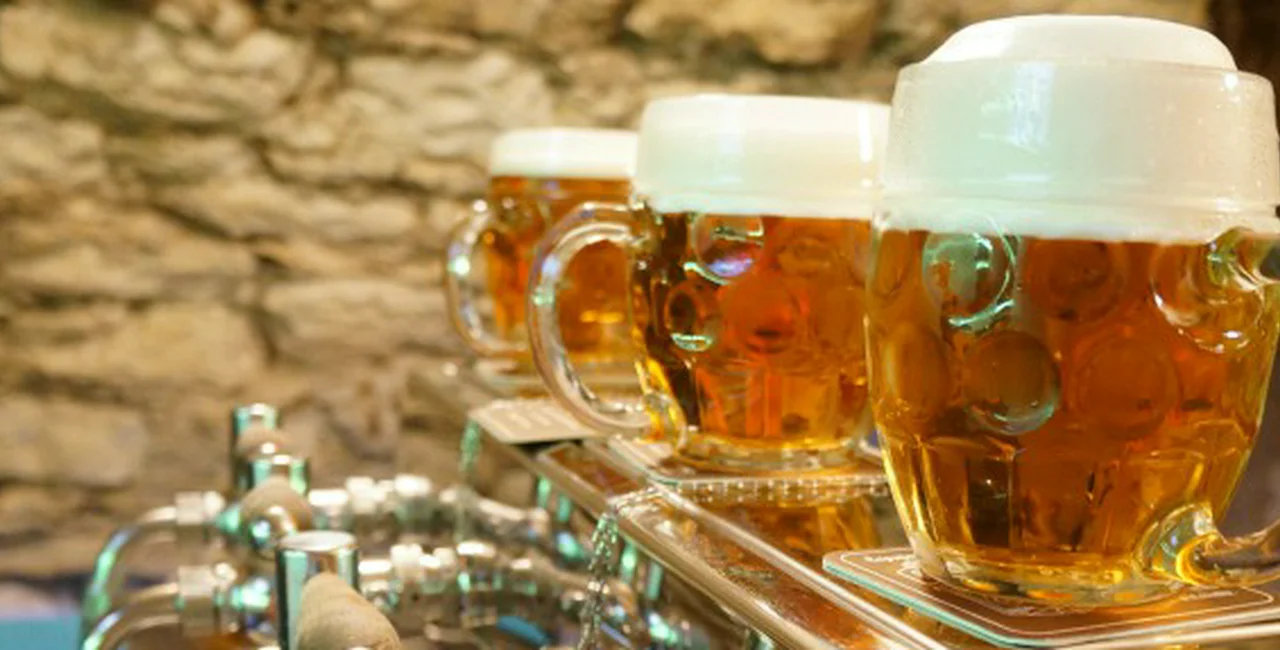We’ve all poured a beer too enthusiastically, only to be left holding a glass of foam, sheepishly awaiting the bubbles to dissipate in order to get at the golden nectar underneath. Clearly there is more to beer pouring than meets the eye – so much so that a new course devoted to the perfect pour is now being offered (in English) by Master Bartender Lukáš Svoboda at Lokál U Bílé kuželky in Malá Strana.
Learning from a true master
I recently sat down with Svoboda, a mistr světa v čepování piva, or World Champion Beer Draughter, to discuss the course and brush up my draughting skills. After winning the Pilsner Urquell Master Bartender Competition in 2010 against 2,500 other bartenders from around the world, he was asked by Lokál to be caretaker of beer at their restaurants. Not only does he maintain the quality of the beer, but he also carefully selects and trains bartenders. And not every bartender is created equally.
“The most important thing for a barman is to have passion,” Svoboda told me enthusiastically. Bartenders should take pride in their job and truly care about the beer they are serving. I would soon find out that draughting beer correctly requires a lot of practice and precision.
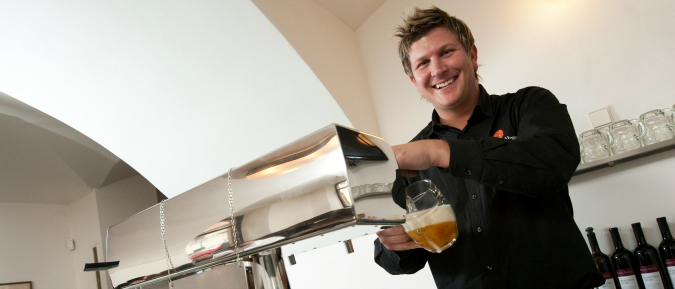
Master Bartender Lukáš Svoboda
The proper way to pour Pilsner Urquell involves only one step. Once the tap is opened, the bartender should fill the glass without stopping or pausing. Svoboda described four different ways to pour, all of which have varying amounts of foam. The first, called čochtan, has basically no foam at all. This style is not ideal for Pilsner, which is meant to be served with a frothy head. We spent most of the time talking about the three most common types: hladinka, šnyt, and mlíko.
The holy trinity of Czech beers
Hladinka (the diminuitive form of “water level”) is the standard style, with about one quarter foam. The foam line should sit slightly below the half-liter mark, bringing the beer even with the line when it settles. A šnyt, according to Svoboda, should contain “two fingers of beer, three fingers of foam, and one finger of empty glass.”
Šnyt is an old-fashioned, mostly forgotten method of drinking beer. Historically, it was simply a small “cut” of beer and was typical for beer connoisseurs. It was also meant for someone who wanted less than a full glass, yet wanted to avoid the shame of ordering a small beer. Karel Čapek wrote a passage called “Ohrožený šnyt” or “Endangered šnyt” in which he complained that šnyt was disappearing from pubs. Lukáš is doing his best to bring it back.
The third type, mlíko, or a “milk” beer, is a glass almost entirely full of foam, except for a sliver of beer at the bottom. Mlíko is typically drunk at the end of the night. The foamy, sweet taste gives the drinker a jolt of energy before stumbling home.
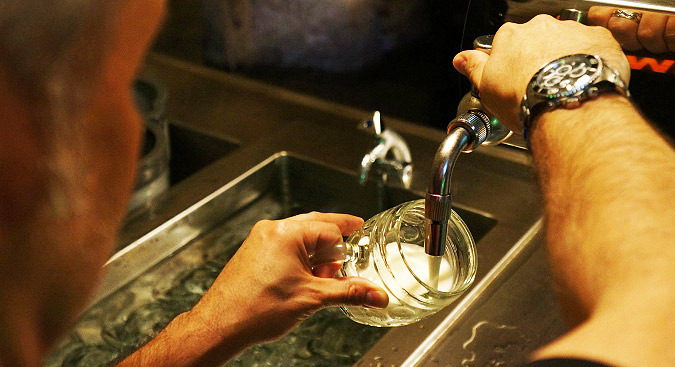
The key to successful tapping is regulating how much foam you produce. This depends on how far the spout is from the glass, the angle of the glass, and how much the tap is opened. For each specific pour, you have to carefully control the flow of the beer to achieve the desired amount of head. And since Pilsner is supposed to be poured in one step, there is no going back if you make a mistake.
For mlíko, you keep the flow gentle right up until the last moment. Svoboda put one in front of me and said that mlíko is meant to be drunk “na X,” which means to finish it all in one drink.
I did as I was told. Since mlíko is mostly foam, it went down smoothly with little effort. The bubbles have a sweet, creamy taste without the bitterness that we have come to expect from Pilnser Urquell. It was definitely a different beer-drinking experience. And I didn’t even have to burp.
Lukáš Svoboda’s School of Draught Beer
Following my initial crash course, Svoboda invited me to join his beer draughting school that is offered periodically at U Bílé kuželky. The course began in Czech, but is now offered in English as well. We were joined by bartender Mickey Ray Alexander, who has worked at Hospoda, Lokál’s gastropub in New York.
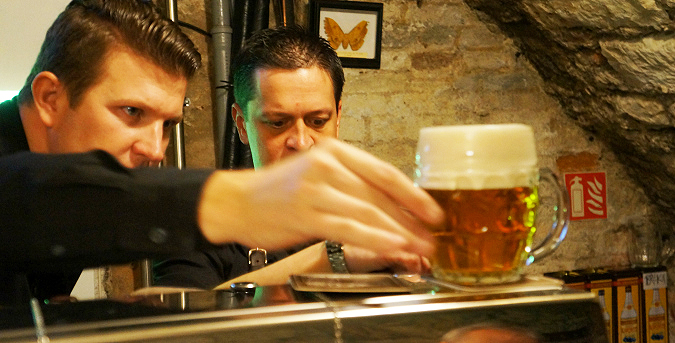
Svoboda and Hospoda NYC’s Mickey Ray Alexander
The price for the course (3,200 CZK) may be a bit steep for Prague expats on a budget, but it does cover a lot of ground for people lacking in beer knowledge. The 3-4 hour course includes a history of beer, information on the brewing process, a four-course lunch with beer pairings for each dish, as well as guided instruction on how to pour Pilsner Urquell.
The five people, including myself, who joined the course represented a cross-section of Prague expats. A Hungarian man had received a voucher for the course as a gift from his girlfriend. Two long-term expats just wanted to find out more about the beer they have grown to love over their years in Prague. And then there was me, the beer nerd hoping to find out something I didn’t already know.
I already knew a lot of the beer facts which were presented, but it was new information for most of the others. The course may be better suited for beer novices or groups of friends or colleagues looking for a unique beer experience. Lukáš and Mickey keep the atmosphere relaxed and informal, and the passion they have for beer is evident.
Putting theory to practice
When the time came to pour our own beer, I felt pretty confident. I had already been through this once, so I figured I would show the others how it’s done. Unfortunately, my confidence didn’t translate into success. My čochtan had a bit too much foam, while my mlíko had a little too much liquid. After a couple of unsuccessful tries, I managed to produce a fairly decent šnyt.
However, when I tried to pour a hladinka, I completely fell apart. Whether it was a lack of focus or the six sets of eyes closely watching me, I just couldn’t get it right. On the first try, I held the glass too far from the tap. Too much foam.
“Do it again,” Lukáš said while gesturing to the empty glasses.
On my second attempt I was too hesitant to open the tap fully, which also resulted in too much foam. After the beer starts flowing, it isn’t so simple to keep it under control.
“Once more,” my beer coach instructed. The pressure was mounting.
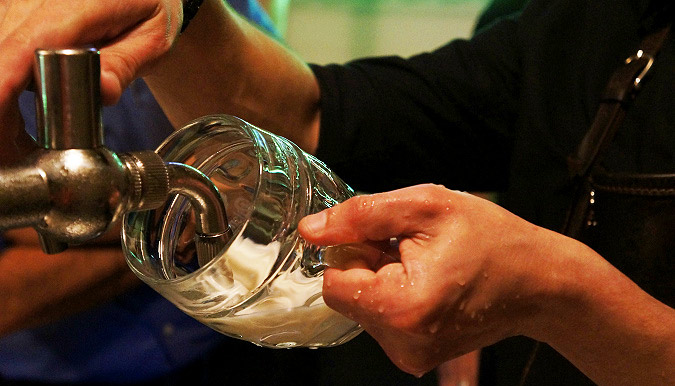
Finally on my fourth attempt, I managed to get it pretty close. I wasn’t satisfied with my effort, and I am sure that Lukáš and Mickey were not terribly impressed either. However, I was grateful they let me “pass” the course anyway.
This experience made me recall a beer proverb I heard from a Czech person several years ago. He said that for good beer, 50% of the responsibility lies with the brewer. The other 50% is up to the barman. Now, I fully understand what he meant. The next time you are presented with a beautifully poured beer, appreciate the effort that the bartender put into it. I certainly will.
Lukáš Svoboda’s School of Draught Beer
Lokál U Bílé kuželky, Malá Strana
Next sessions: November 11, 23, December 12, 14
14:00-18:00
Class applications are available on-line.
**
Photos by Jan Pukrabek; photo of Mr. Svoboda courtesy of 2media.cz.
Related articles












 Reading time: 6 minutes
Reading time: 6 minutes 